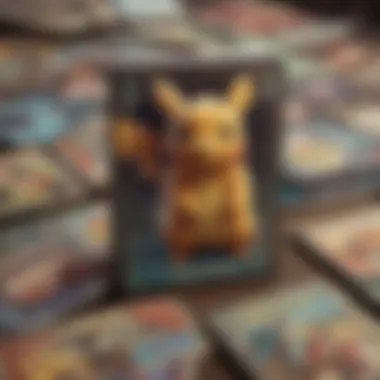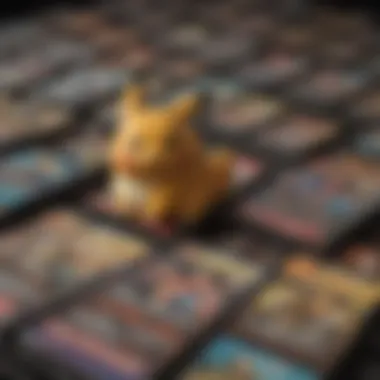Exploring the Value of Vintage Pokémon Cards


Intro
The market for old Pokémon cards has grown significantly over the past few years. Collectors, investors, and nostalgic players are drawn to the vibrant history and cultural impact of these cards. With each passing year, the prices of select cards have risen dramatically. Understanding the factors that influence these prices is crucial for both enthusiasts and investors alike. Over the course of this article, we will explore various elements that shape the current landscape, including trends in pricing, significant cards that hold value, grading systems that determine authenticity, and the platforms where these transactions take place.
The interest in retro collectibles has surged. As a result, the dynamics of demand and supply in this niche market are complex. From iconic legendary cards like Charizard to limited editions, every card tells a story. But how do these stories translate into monetary value? Here, we will unpack these intricacies while providing insights for both casual fans and serious collectors who approach this market with the intention of investment.
With a foundation established, let us delve into the latest trends, reviews, tips, and topics relevant to the world of old Pokémon cards.
Foreword to Pokémon Card Collecting
Pokémon card collecting holds significant appeal across various demographics. It intertwines nostalgia and investment potential, making it an intriguing subject for enthusiasts. This section aims to explore the intricacies surrounding this hobby, shedding light on its origins and cultural resonance among collectors. Understanding the roots of Pokémon card collecting can offer valuable insights into why certain cards command higher prices in the market.
A Brief History of Pokémon Cards
The journey of Pokémon cards began in the late 1990s. Created by Satoshi Tajiri and launched by Nintendo, Pokémon became a cultural phenomenon, attracting a wide audience. The trading card game was introduced in 1996 in Japan and soon made its way to international markets. Initial releases included the Base Set, which contained iconic cards like Charizard and Blastoise. These cards became highly sought after, and their demand only intensified over time.
The 2000s witnessed a surge in various expansions and series, each contributing to the evolving landscape of Pokémon cards. Collectors started to categorize cards based on rarity, such as First Edition cards and holographic variants. This categorization played a crucial role in determining future card prices. As collectors sought to complete their sets, the market adapted, leading to fluctuations in card value based on supply and demand.
Understanding this history helps collectors appreciate the significance of certain cards. It also sets the stage for examining how market dynamics today continue to influence card prices.
The Cultural Impact of Pokémon Cards
Beyond being mere collectibles, Pokémon cards have influenced culture significantly. The franchise has created a sense of community among fans, fostering social interactions at events like tournaments and conventions. Collectors often share their experiences via forums and social media platforms like Reddit and Facebook, engaging in discussions about their collections and market trends.
Moreover, the resurgence of Pokémon within modern media has reignited interest in card collecting. Recent releases of video games, animated series, and films related to Pokémon have strengthened its presence in popular culture. This renewed visibility has had direct implications for the price of older cards by driving demand among both seasoned collectors and newcomers.
Additionally, with the rise of influencers and content creators focusing on card collecting on platforms like YouTube, there has been a burgeoning interest in cards as a form of investment. People are increasingly viewing cards not only as nostalgic items but also as financial assets capable of appreciating in value over time.
In summary, the roots and cultural importance of Pokémon cards set a solid foundation for exploring their pricing and market behaviors. Collectors are not only buying pieces of card stock; they are investing in a rich legacy that continues to shape their experiences and values.
Understanding the Market Dynamics
Understanding the market dynamics of old Pokémon cards is crucial for both collectors and investors. The pricing of these cards does not operate in isolation but is affected by various interconnected factors. By analyzing these elements, collectors can make informed decisions. Knowing the fundamentals can help identify opportunities and risks associated with the investment in such collectibles.
The market for old Pokémon cards is influenced by elements such as rarity, condition, and popularity. These factors determine how much someone is willing to pay for specific cards. Moreover, understanding these dynamics reveals the broader trends within the collectible market and helps anticipate future movements. When someone learns about the market dynamics, they become more proficient in navigating this niche space.
Factors Influencing Card Prices
Rarity
Rarity is one of the most significant factors impacting the price of Pokémon cards. The less frequently a card is found, the more desirable it becomes to collectors. Rare cards often fetch higher prices due to their limited availability. This trend is evident in First Edition cards, which are always in high demand.
A key characteristic of rarity is its intrinsic value in the eyes of collectors. Many collectors pursue rare cards as a status symbol within the community. Unique features such as promo cards from special events often carry a clear rarity designation, making them particularly sought after.
However, the downside of rarity is that not every collector can afford these high-value cards, which can result in a segmented market. Rare cards may see extreme price fluctuations based on market trends, making it a strategic but risky venture for investors.
Condition


Condition plays a critical role in determining a card's market value. A card in pristine condition typically commands a higher price than one with visible wear and tear. Collectors often prioritize condition because it directly affects the potential resale value of a card. Conditions are graded meticulously, focusing on issues like corners, edges, surface quality, and centering.
The unique aspect of condition is that it is an objective measure in many cases, enforced by grading companies such as PSA or Beckett. High-grade cards, particularly those rated 9 or above, consistently yield more money on the secondary market.
Nevertheless, the condition aspect can also be tricky. Not every collector will be concerned about the minor imperfections of a card, leading to price variances even within the same rarity category.
Demand and Popularity
Demand and popularity are interlinked factors that significantly determine a card’s price. A strong demand can drive up prices remarkably, particularly when a specific card is popular due to nostalgia or its portrayal in media, such as the Pokémon animated series or video games.
The essential characteristic of demand arises from cultural phenomena. Cards featuring beloved characters, such as Charizard, often see substantial spikes in prices when they become the centre of attention in the gaming community or social media.
However, popularity can be fleeting. Cards that are in high demand today may lose their appeal with changing trends, leading to reduced prices. This aspect makes it important for collectors to be aware not only of current demand but also of potential shifts in popularity.
The Role of Grading in Pricing
Grading is a crucial aspect of the Pokémon card market. A consistent grading system provides collectors a clear understanding of a card’s potential value. Grading services evaluate cards based on set criteria, which helps standardize the market.
A higher grade generally translates to a higher market value, confirming the card's quality. For example, a graded Gem Mint card typically sells for significantly more than an ungraded, lower-quality card. This system of grading facilitates trust between buyers and sellers.
However, reliance on grades can sometimes lead to overvaluation. Collectors should be cautious and perform due diligence even when dealing with graded cards. The grading process is not infallible, and discrepancies can occur.
Ultimately, understanding these market dynamics offers valuable insights into the old Pokémon card market, allowing collectors and investors to navigate this exciting, yet sometimes unpredictable, landscape.
Categories of Pokémon Cards
In the realm of Pokémon card collecting, understanding the categories of cards is crucial. Each category presents unique characteristics and value propositions that appeal to various collectors. Factors such as rarity, demand, and historical significance contribute to the overall pricing. Familiarizing oneself with categories helps collectors make informed decisions, ensuring a more strategic approach to building their collections.
First Edition Cards
First Edition cards hold a special place in Pokémon history. Introduced in the initial print run of the base set, these cards feature a distinctive "First Edition" stamp. This emblem denotes authenticity and rarity, making them highly sought after. Collectors view First Edition cards as iconic pieces of the Pokémon franchise. They often fetch higher prices due to their limited availability and nostalgic value.
The primary appeal of First Edition cards lies in their cultural significance. They represent the beginning of a phenomenon that transcended generations. For many collectors, owning a First Edition card is like possessing a piece of history. Some notable examples include Charizard and Pikachu, which can command prices in the thousands depending on their condition and grading.
Holofoil and Reverse Holo Cards
Holofoil and Reverse Holo cards also capture significant attention within the collecting community. Holofoil cards are characterized by their shiny surface, which reflects light beautifully. This aesthetic appeal enhances their value, making them popular among collectors who prioritize visual aspects.
Reverse Holo cards, on the other hand, feature a shiny background while the Pokémon image remains non-holographic. Collectors often seek these cards for their unique look and rarity. Certain Holofoil cards have sold for exceedingly high prices, especially when they are vintage or feature fan-favorite Pokémon. The interplay of art and rarity contributes to the desirability of these cards, ensuring they remain a staple in any serious collection.
Promo Cards
Promo cards, often released to commemorate events or collaborations, add another layer of complexity to the card market. These cards typically come in limited quantities, contributing to their rarity. Promo cards can be obtained through various means, such as tournaments, conventions, or special set releases.
The pricing of Promo cards varies widely. Some might be moderately priced, while others can fetch impressive sums depending on their execution and context. Notable examples include cards distributed during the early 2000s to promote movie releases and special events. Collectors often seek these cards for their connection to Pokémon’s broader cultural narratives. Understanding the nuances of Promo cards helps collectors identify opportunities for investment and enhances the overall collecting experience.
"Mastering the categories of Pokémon cards is essential for serious collectors. It not only impacts pricing but also influences long-term investment strategies."
By grouping Pokémon cards into these distinct categories, collectors can build a more precise understanding of the market. Recognizing the value of First Edition, Holofoil, Reverse Holo, and Promo cards ensures that collectors are equipped with the knowledge necessary to navigate this intricate sector effectively.


Historical Pricing Trends
Understanding historical pricing trends is crucial for anyone interested in the value of old Pokémon cards. These trends serve as a lens through which collectors, investors, and enthusiasts can analyze the shifts in market demand and economic factors at play. The fluctuations in prices over the years can reveal underlying patterns that inform future predictions about the market.
As the years go by, awareness of Pokémon cards and their various values has grown. This growth is marked by significant price changes influenced by multiple elements, including the state of the economy, changes in collector interest, and the introduction of new media related to Pokémon.
Price Changes Over the Years
Prices of Pokémon cards have undergone dramatic shifts since their initial release in the late 1990s. In the early years, most cards had negligible value, with players primarily focusing on gameplay rather than collecting. As the franchise expanded, however, attention shifted. The introduction of First Edition cards began a trend that saw certain cards appreciate significantly in price.
- 1999-2000: Initial hype around the game led to some cards experiencing price inflation. Common cards were often worth just a few cents, while rare holographic cards could fetch higher amounts—sometimes reaching hundreds of dollars.
- 2005-2010: The market for Pokémon cards stabilized, with prices generally declining as the initial excitement waned. Many collectors originally holding onto cards sold them off, often at significantly reduced prices.
- 2015-2020: Renewed interest in nostalgia coinciding with the 20th anniversary launched the prices upward again. Major auction sites recorded sales of rare cards, resulting in strata of value not seen before. Common cards were still low in value, but rare editions soared, some even auctioning for tens of thousands.
- 2021-Present: The pandemic accelerated online sales, and hobbies like card collecting became more popular. This contributed to massive price inflations for specific cards, with some selling for hundreds of thousands of dollars.
This timeline signifies fundamental shifts and offers insight into particular events and benchmark moments that have affected pricing.
Impact of Entertainment Media
The relationship between Pokémon cards and entertainment media cannot be understated. Movies, television shows, and the rise of streaming services have had profound impacts on the popularity and, consequently, the pricing of collectible cards.
The impact can be distilled into a few key components:
- Media Releases: New releases of Pokémon films or series reinvigorate interest in the franchise. For example, the release of “Detective Pikachu” in 2019 sparked new interest in older cards, particularly those featured within the movie.
- Influencer Attention: Social media has created a new era of influencers who discuss and promote card collecting. Famous streamers and YouTubers showcasing card openings can elevate the market, leading to increased demand.
- Collaborations and Merchandise: When collaborations occur between Pokémon and other franchises, or brands create special collector boxes, it brings attention back to the cards, often prompting immediate effects on price.
"The resurgence of interest in Pokémon cards often mirrors the cultural zeitgeist, where shifts in the media landscape create a ripple effect on collectible values."
Major Card Sales and Auctions
The realm of major card sales and auctions plays a crucial role in the valuation of old Pokémon cards. High-profile auction events serve not only as a marketplace but also create a spectacle, drawing attention to the wider dynamics of the collectible card space. The excitement generated by these auctions can elevate interest among collectors and novices alike, contributing to the fluctuating prices of Pokémon cards.
High-Profile Auctions
High-profile auctions feature some of the most sought-after Pokémon cards, including rare first editions and holographic gems. These events attract attention because they can instigate rapid price increases that may not reflect everyday market conditions. For instance, when a first edition Charizard card with a perfect PSA (Professional Sports Authenticator) grade goes on the block, the bids can surge into six-figure sums. Such sales serve as benchmarks for the market, influencing private transactions and setting trends for the valuation of similar cards.
Factors contributing to the frenzy at these auctions include:
- Rarity: Cards that are exceedingly rare tend to see the highest bids. A card's scarcity significantly influences its value, and auctions are often the venue where this rarity is showcased.
- Condition: The grading of cards plays a pivotal role. Cards with higher grades usually fetch better prices, which becomes evident in auction outcomes.
- Provenance: The history of ownership can also impact prices. Legendary collectors or notable personalities owning a card can increase its desirability and perceived value.
This environment of competitive bidding creates a spectacle, revealing not only the depth of passion among collectors but also the tangible monetary interest surrounding Pokémon.
Influence of Online Marketplaces
Online marketplaces have transformed the way collectors engage with Pokémon cards, making the acquisition and sale process more streamlined and transparent. Platforms such as eBay, TCGPlayer, and even dedicated trading forums like Reddit's r/pkmntcg have redefined buying patterns and established new norms in pricing.
The rapid rise of these platforms has several implications for the market:
- Accessibility: More collectors gain access to the market. Hybrid sales strategies (online/offline) empower individuals to sell or auction their cards without geographical constraints.
- Price Discoverability: Online listings provide a direct window into typical price ranges for cards, giving buyers a clearer understanding of what they should expect to pay. This democratization of information plays a significant role in establishing fair market value.
- Community Engagement: Online forums foster discussions about card conditions, market trends, and investment strategies. Community insights contribute to shaping perceptions of a card's value.
Collectors' Perspectives
Understanding the views and experiences of collectors provides essential insight into the market for old Pokémon cards. Collectors play a vital role in shaping these prices and driving demand. Their passions, motivations, and shifting preferences directly influence what cards are considered valuable, both in monetary terms and in cultural significance. By examining collectors' perspectives, one can grasp the nuances behind price fluctuations and market trends that may not be immediately apparent through simple statistics or sales data.


Notable Collectors and Their Collections
Various notable collectors have significantly impacted the Pokémon card market. These individuals often possess expansive collections made up of rare and sought-after cards. Names like Gary Hagman, who is known for his vast collection including several First Edition holographic cards, exemplify the dedication within the collecting community. Hagman's collection not only showcases the beauty of these cards but also highlights their potential investment value.
Many collectors share their journeys through platforms such as Instagram or YouTube. This visibility can lead to increased interest in specific cards or sets. For instance, when rare cards are showcased, especially those with pristine grading, it can elevate their desirability among potential buyers. The concept of "following" on these platforms allows collectors to connect, trade, and sell, which naturally influences market dynamics.
Beyond individual collections, some collectors have turned their passion into a business, creating platforms to buy and sell trading cards at an accelerated pace. Their insights into the demands of the market not only assist in determining current prices but also help predict future trends.
Community Opinions on Market Value
The community surrounding Pokémon card collecting often engages in discussions about perceived market values, with opinions varying greatly. Many collectors utilize online forums and social media, such as Reddit and Facebook, to express their views, share price updates, and even critique recent auction results. This collective wisdom can provide fresh perspectives on price valuations.
Community members may assess market value based on various factors, including:
- Condition of the card
- Rarity, such as whether it is a First Edition or a promo card
- Current trends in popular media, influencing demand
The dialogues surrounding these topics reveal a wealth of knowledge from enthusiastic participants. Often, decisions to buy or sell cards are influenced by shared insights or market predictions. Some of these discussions highlight how community consensus can create a cycle of demand, subsequently influencing prices. > "The Pokémon card community is as much about camaraderie as competition; collectors learn from each other about what cards truly hold value."
Understanding both notable collectors and broader community perspectives can elucidate the factors that shape the pricing of old Pokémon cards. Engaging with this community creates a cycle of knowledge that significantly impacts purchasing behaviors and overall market value.
The Future of Pokémon Card Values
The future of Pokémon card values is a crucial topic in understanding the collectibles market. It is essential to consider how the evolving interests of collectors and shifts in the market landscape can influence these values. With the Pokémon brand continuing to thrive in various forms of media, the demand for older cards remains significant. Consequently, understanding potential price trajectories and market dynamics is vital for both collectors and investors alike.
Predictions Based on Current Trends
Current trends indicate a mixed trajectory for Pokémon card values. Recently, there has been a resurgence in popularity, particularly regarding nostalgia-driven collecting. Older cards, especially first edition and holographic variants, have seen surging interest. This trend aligns with broader cyclical patterns where certain collectibles gain traction after periods of dormancy.
Experts suggest that as long as the Pokémon franchise maintains relevance, cards could sustain or even increase in value. One may notice that the emergence of digital platforms for trading cards might also influence traditional markets. Collectors who once relied solely on physical exchanges can now tap into online auctions and marketplaces.
Moreover, the impact of social media plays a significant role. Platforms such as Reddit and Facebook provide spaces for communities to assemble, sharing insights and driving demand for specific cards. These platforms not only highlight trending cards but also stimulate discussions about pricing and perceived value.
Potential Market Shifts
As the landscape of collectibles evolves, several potential market shifts may arise. Firstly, the introduction of new generations of collectors could reshape demand. As adults who grew up with Pokémon pass their interest to younger individuals, a new base of collectors may prioritize different cards and subsets. This generational shift could lead to fluctuations in values as older cards gain a new wave of interest.
Additionally, the increasing influence of environmental sustainability in consumer habits might affect collectible markets. An inclination towards sustainable practices could lead collectors to favor trading and collecting in a manner that reduces environmental impact, which may, in turn, influence pricing trends.
"The continued success of the Pokémon franchise suggests that the fascination with its cards is far from over; rather, it may be on the precipice of a resurgence."
Ending
The conclusion of this article synthesizes the insights gathered throughout the discussion on the price of old Pokémon cards. This topic holds significance not only for collectors but also for investors looking to navigate this unique niche market. Understanding the factors that influence prices, such as rarity, condition, and demand, provides individuals with a more informed approach to their collections.
Summary of Key Insights
The key insights highlighted in this article include several crucial elements:
- Market Dynamics: The intricate balance between supply and demand directly affects card prices. Factors like rarity and condition play a pivotal role.
- Grading Importance: Professional grading systems, like those from PSA and Beckett, contribute significantly to pricing, as they provide buyers assurance about the card's quality.
- Trends Over Time: Historical pricing patterns reveal that certain cards can accelerate in value based on trends in pop culture and media, showcasing the card's relevancy.
Final Thoughts on Collecting
Collecting Pokémon cards extends beyond just a hobby; it embodies the blend of nostalgia and investment strategy. As the market grows, so does the community around collecting. Whether for sentimental value, the thrill of acquiring rare cards, or investment potential, collectors must stay engaged and continuously educate themselves on market shifts. The landscape is evolving, and those who adapt will thrive.
Collecting Pokémon cards remains a dynamic pursuit, cherished by many. This increasing interest brings not only financial considerations but also a rich cultural context. In essence, fostering this knowledge equips collectors to make savvy decisions and to appreciate the artistry and history behind every card.







